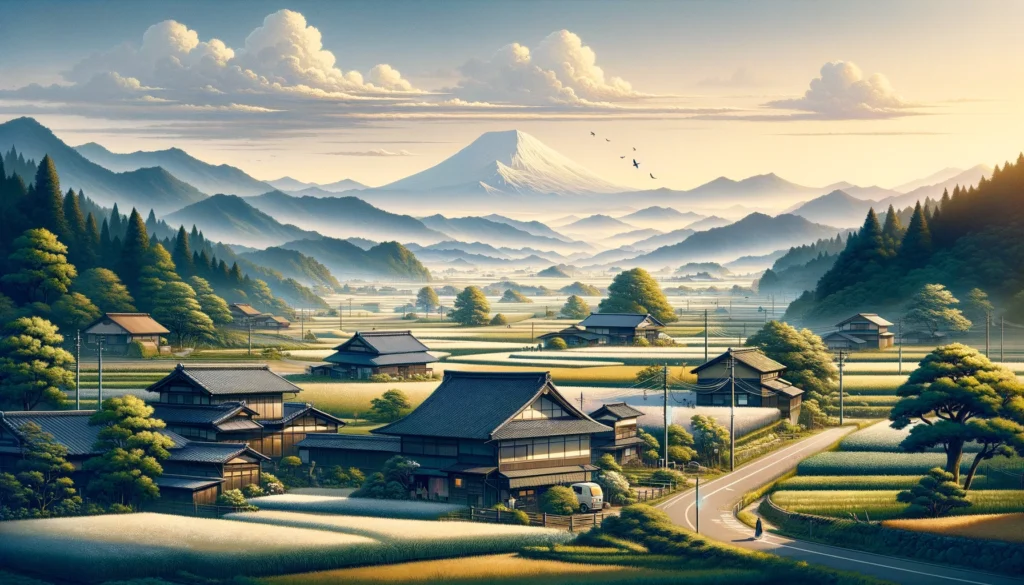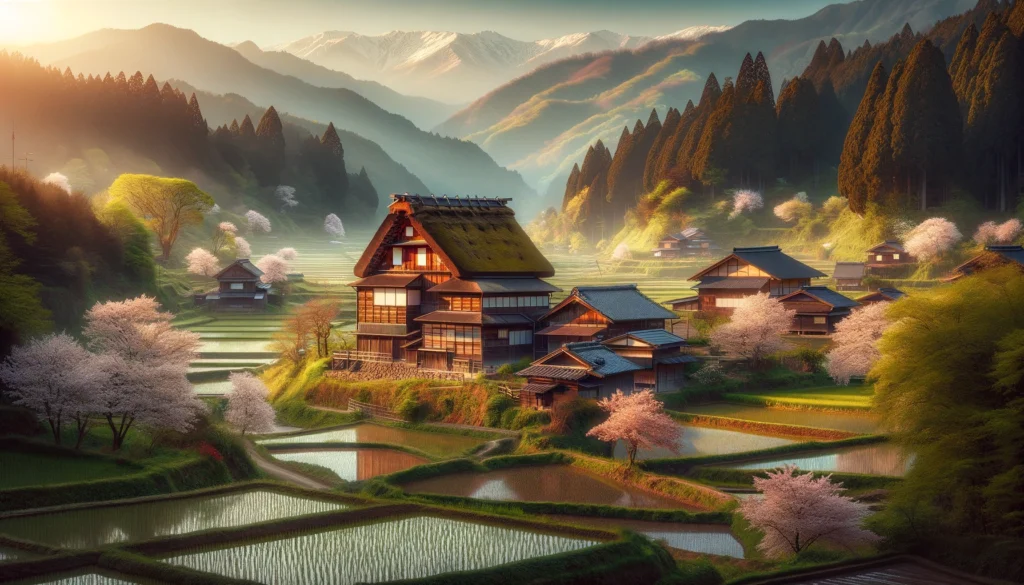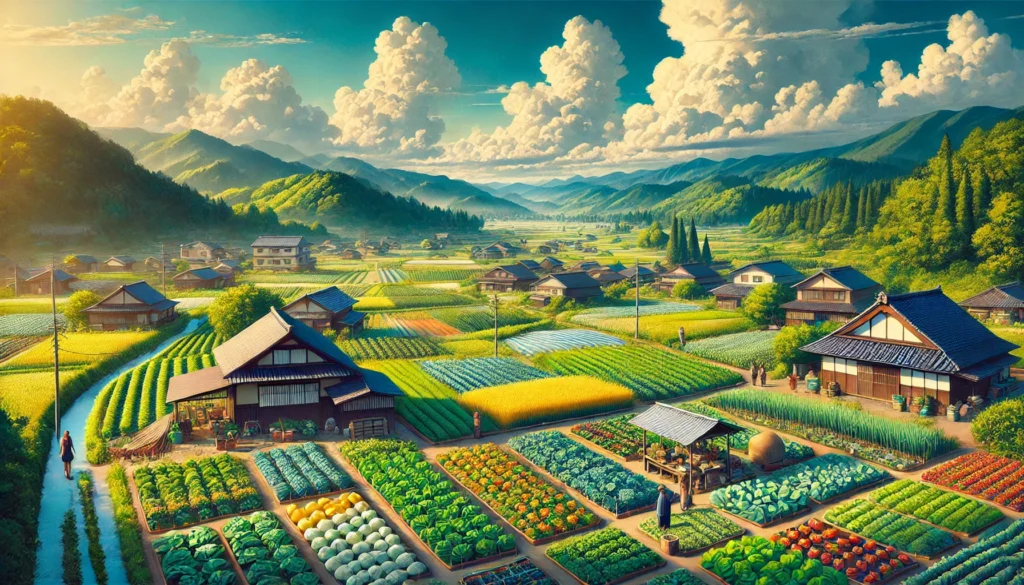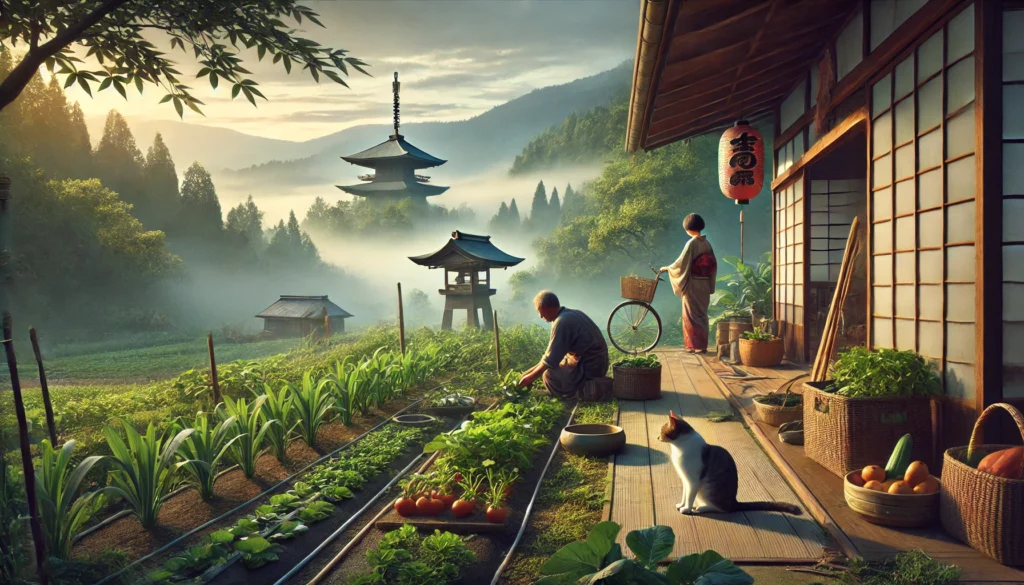Imagine waking up to the gentle sound of birds chirping, the crisp morning air rolling through your open window, and a breathtaking view of mist-covered rice fields stretching into the horizon. The only sounds you hear are the occasional chatter of farmers preparing for the day and the soft rustling of trees in the breeze.
For many, living in the Japanese countryside (inaka, 田舎) is a dream of simplicity, nature, and affordability. While Japan is often associated with the fast-paced, high-tech lifestyle of Tokyo and Osaka, there’s another side—one where living costs are lower, the pace is slower, and the community is tight-knit.
But is inaka life the right choice for you? Can moving to rural Japan help you escape the high cost of city living while offering a more fulfilling lifestyle?
In this guide, we’ll explore what life in rural Japan is really like, the financial benefits, and the challenges. Whether you’re looking for cheaper housing, a break from urban stress, or a fresh start in Japan, this article will help you determine if rural Japan is your perfect escape.
📌 Let’s dive in and explore the real cost of living in rural Japan!
What is Inaka?
The word “inaka” (田舎) directly translates to “countryside” in Japanese, but its meaning goes beyond just geography. Inaka life represents a completely different lifestyle from urban Japan—one that revolves around nature, community, and a slower pace of life.
🌿 Why Do People Move to Inaka?
✅ Affordable cost of living – Rural areas offer cheap or even free housing, lower daily expenses, and less financial stress compared to major cities like Tokyo and Osaka. (More on this in the cost breakdown!)
✅ A deeper connection to nature – Imagine mountains, rice fields, hot springs, and fresh air instead of traffic jams and concrete skyscrapers.
✅ Cultural immersion – Inaka is home to rich traditions, local festivals (matsuri), and close-knit communities that still practice time-honored customs.
✅ Government incentives & subsidies – The Japanese government actively encourages people to move to rural areas through programs like the Akiya Bank (空き家バンク), which offers abandoned houses (akiya) at extremely low prices—or even for free. There are also financial grants to help cover moving and renovation costs.
📌 Real-Life Example: A Foreigner’s Move to Rural Japan
After years of living in Tokyo, John, an American software developer, realized he was tired of the stress and high costs of urban life. He discovered the Akiya Bank program, bought a traditional Japanese house for under ¥500,000 ($3,500 USD), and now enjoys a peaceful life growing his own vegetables and working remotely.
For many like John, the lower cost of living in rural Japan and the promise of a simpler, more rewarding life make inaka an attractive option.
📌 Could rural Japan be your next home? Let’s compare city vs. countryside living!

Urban vs. Rural Japan: Key Differences
One of the biggest questions people ask before moving to Japan is:
“Should I live in a big city like Tokyo or try the rural inaka lifestyle?”
Each option comes with advantages and challenges, depending on what you value most. Let’s break down the key differences between urban and rural Japan to help you decide.
🏙️ Life in a Japanese City (Tokyo, Osaka, Kyoto, etc.)
✔️ Endless convenience – Trains, 24-hour stores, shopping malls, and entertainment at your fingertips.
✔️ More job opportunities – Tokyo and Osaka offer higher salaries and a wider range of careers.
✔️ Exciting nightlife & social scene – Bars, restaurants, and international communities.
❌ Expensive housing – Rent can reach ¥200,000+ ($1,500 USD) per month for a small apartment.
❌ High cost of living – Food, transportation, and utilities add up quickly.
❌ Overcrowding & stress – Long commutes, packed trains, and a fast-paced lifestyle.
🌾 Life in Rural Japan (Inaka)
✔️ Affordable or free housing – Rent can be as low as ¥20,000–¥50,000 ($150–$350 USD) per month, or free with Akiya Bank programs.
✔️ Lower cost of living – Groceries, dining, and transportation are much cheaper than in cities.
✔️ Tight-knit communities – Neighbors often share food, resources, and help each other.
✔️ Access to nature – Rivers, forests, onsens, and fresh, clean air.
❌ Fewer job opportunities – Many rural areas rely on agriculture, tourism, or remote work.
❌ Car dependency – Public transport is limited, so most people need a kei car (compact Japanese car).
❌ Cultural adjustment – Fewer English speakers and more traditional customs to adapt to.
📊 Cost of Living: Tokyo vs. Rural Japan
| Expense | City (Tokyo, Osaka) 🏙️ | Rural Japan (Inaka) 🌾 |
|---|---|---|
| Rent | ¥80,000–¥250,000/month | ¥20,000–¥50,000/month (or free) |
| Groceries | ¥30,000–¥50,000/month | ¥15,000–¥30,000/month |
| Public Transport | ¥10,000–¥30,000/month | ¥5,000/month (or car expenses) |
| Dining Out | ¥800–¥3,000/meal | ¥500–¥1,500/meal |
| Car (if needed) | Not necessary | ¥15,000–¥30,000/month |
| Utilities (Electricity, Water, Gas, Internet) | ¥15,000–¥30,000/month | ¥8,000–¥20,000/month |
📌 Key Takeaways:
- City life is great for career-driven individuals who love convenience and excitement.
- Rural life is ideal for those seeking affordability, peace, and a slower lifestyle.
- The cost of living in rural Japan is significantly lower, but you’ll need to adjust to cultural and transportation differences.

Love Japan? Stay in the Loop!
Get the latest cultural insights & updates straight to your inbox. 📩
The Cost of Living in Rural Japan
When considering a move to rural Japan, one of the biggest advantages is the significantly lower cost of living compared to cities like Tokyo or Osaka. From housing and utilities to food and transportation, life in the Japanese countryside (inaka) offers affordability while providing a slower, more relaxed lifestyle.
📌 Let’s break down the cost of living in rural Japan in detail!
🏠 Housing Costs: Buying vs. Renting
Housing in rural Japan is drastically cheaper than in urban areas. Whether you rent a house, buy an akiya (abandoned house), or build a new home, the costs are much lower than in Tokyo, where even small apartments can cost upwards of ¥150,000/month ($1,000 USD).
Rental Costs in Rural Japan
- Traditional Rental: ¥20,000–¥50,000/month ($135–$350 USD) for a full-sized house, often with a garden.
- Government-Subsidized Housing: Some municipalities offer incredibly cheap rental housing for families or those looking to work in the countryside.
Buying Property: Akiya Houses vs. New Builds
Many rural properties are part of the Akiya Bank (空き家バンク), a government-backed initiative that lists abandoned homes at extremely low prices—or even for free!
- Akiya Houses (Abandoned Homes): ¥0–¥5,000,000 ($0–$35,000 USD)
- New Houses: ¥10,000,000–¥25,000,000 ($70,000–$180,000 USD)
💡 Pro Tip: While akiya homes can be incredibly cheap, they often require significant renovations, from plumbing repairs to earthquake reinforcements.
📌 Housing Takeaway:
- Rent is 5x–10x cheaper than in cities.
- Akiya homes are an affordable way to own property, but renovation costs should be considered.
- New builds are still cheaper than city apartments but require more investment.
💡 Utility Bills in Rural Japan
Even though rent is low, utilities can vary depending on house size, insulation, and location.
| Utility | Cost in Rural Japan (Monthly) |
|---|---|
| Electricity | ¥5,000–¥12,000 ($35–$85 USD) |
| Gas (Propane) | ¥3,000–¥8,000 ($20–$55 USD) |
| Water | ¥1,500–¥3,000 ($10–$20 USD) |
| Internet & Phone | ¥4,000–¥8,000 ($28–$55 USD) |
| Winter Heating (Kerosene Stoves) | ¥10,000–¥20,000 ($70–$140 USD) during winter months |
Winter heating costs can be higher than expected, especially in places like Hokkaido or the mountains. Many rural homes don’t have central heating, so kerosene stoves and electric heaters are necessary.
📌 Utility Takeaway:
- Total monthly utilities range between ¥12,000–¥30,000 ($85–$210 USD).
- Winter can drastically increase heating costs.
- Propane gas for cooking is more common in rural areas.
🚗 Transportation: Car vs. Public Transport
Unlike Tokyo, where trains and buses are everywhere, rural Japan often requires a car for daily life. Public transport exists but is limited in frequency and routes.
Kei Cars (軽自動車) vs. Standard Cars
Many rural residents use kei cars (small, fuel-efficient vehicles) due to their lower tax and insurance costs.
| Cost | Kei Car (軽自動車) | Standard Car |
|---|---|---|
| Purchase Cost | ¥300,000–¥1,000,000 ($2,100–$7,000) | ¥1,500,000+ ($10,000+) |
| Gas (Monthly) | ¥5,000–¥10,000 ($35–$70) | ¥8,000–¥15,000 ($55–$100) |
| Shaken (Car Inspection, Every 2 Years) | ¥50,000–¥100,000 ($350–$700) | ¥100,000–¥200,000 ($700–$1,400) |
| Insurance (Yearly) | ¥30,000–¥60,000 ($200–$420) | ¥50,000–¥100,000 ($350–$700) |
🚄 Public Transport Costs
- Local Bus Fare: ¥200–¥500 ($1.50–$4) per ride
- Trains (Limited Routes): ¥500–¥1,500 ($4–$12) per trip
- Bullet Train (Shinkansen) to Tokyo: ¥10,000–¥20,000 ($70–$140)
📌 Transport Takeaway:
- Owning a kei car is the cheapest option.
- Public transport exists but is not convenient for daily commuting.
- Gas prices fluctuate, so carpooling and bicycles are good alternatives.
🍣 Food & Dining Costs in Rural Japan
One of the best aspects of living in the Japanese countryside is the abundance of fresh, locally grown food. Many residents grow their own vegetables or receive produce from neighbors.
| Expense | Cost in Rural Japan |
|---|---|
| Groceries (Monthly) | ¥20,000–¥40,000 ($140–$280 USD) |
| Eating Out (Ramen, Bento, etc.) | ¥500–¥1,500 ($3.50–$10) per meal |
| Izakaya (Drinks & Food) | ¥2,500–¥4,500 ($17–$30) per night |
Home-cooked meals are cheaper since local vegetables, fish, and rice are abundant. Many rural towns also have small farmers’ markets, offering produce at half the price of supermarkets in big cities.
📌 Food Takeaway:
- Eating out is much cheaper than in Tokyo.
- Grocery bills are lower, especially for those who grow their own food.
- Local farmers’ markets help keep food costs down.
📊 Sample Monthly Budget for a Single Expat in Rural Japan
| Expense | Estimated Cost (¥) | Estimated Cost (USD) |
|---|---|---|
| Rent | ¥30,000 | $210 |
| Utilities (Electricity, Gas, Water, Internet) | ¥18,000 | $125 |
| Groceries | ¥25,000 | $175 |
| Eating Out | ¥10,000 | $70 |
| Transportation (Gas, Insurance, etc.) | ¥15,000 | $105 |
| Entertainment & Miscellaneous | ¥10,000 | $70 |
| Total Monthly Cost | ¥108,000 | $755 USD |
📌 Key Budget Takeaways:
- Living comfortably in rural Japan is possible on ¥100,000–¥150,000 ($700–$1,000 USD) per month.
- Housing is by far the most affordable expense.
- Food, utilities, and transportation are reasonable compared to city prices.
How to Find Housing in the Japanese Countryside
Finding affordable housing in rural Japan is easier than in big cities, especially with government programs like the Akiya Bank (空き家バンク).
🏚️ Akiya Bank: How to Get a Free or Cheap House
- The Akiya Bank lists abandoned homes in rural Japan, sometimes for as little as ¥0–¥500,000 ($0–$3,500 USD).
- Many require renovations, but some are move-in ready.
- Local governments often offer financial assistance for repairs.
🏠 Renting a Traditional Home
- Renting is affordable but can come with key money (礼金) and community obligations.
- Rental Costs: ¥20,000–¥50,000/month.
🔨 Renovating & Maintenance Costs
- Akiya homes often require roof repairs, plumbing fixes, and insulation upgrades.
- Renovation costs: ¥500,000–¥5,000,000 ($3,500–$35,000 USD), depending on size.
📌 Housing Takeaway:
- Renting is straightforward and cheap.
- Buying an akiya is affordable but requires renovations.

Jobs & Remote Work in Rural Japan
One of the biggest concerns for those considering living in the Japanese countryside is how to make a living. While the cost of living in rural Japan is significantly lower than in big cities, finding sustainable work is essential. Fortunately, job opportunities in inaka are expanding, particularly with the rise of remote work and local business ventures.
👩🏫 Traditional Jobs in Rural Japan
Rural Japan does not have the vast corporate job market that cities like Tokyo and Osaka offer, but there are still steady, reliable career options available.
English Teaching Jobs (ALT & Eikaiwa)
- Assistant Language Teacher (ALT) positions are available in rural schools through JET Program and private dispatch companies.
- Eikaiwa (英会話) jobs involve working at private English conversation schools, catering to children and adults.
- Salaries range from ¥200,000–¥300,000/month ($1,400–$2,100 USD).
Farming & Agriculture
- Japan’s aging population means more demand for new farmers.
- Some regions offer agricultural training programs and government subsidies for foreigners interested in farming.
Tourism & Hospitality
- Ryokan (Japanese inns) and guesthouses hire seasonal and full-time staff.
- Some expats open guesthouses, cafés, or traditional inns to cater to visitors looking for an authentic countryside experience.
💻 Remote Work Growth: Freelancing & IT Jobs
With more companies embracing telecommuting, remote work is becoming a viable option for living in rural Japan.
Popular remote jobs:
✅ Software development
✅ Graphic design
✅ Digital marketing & SEO consulting
✅ Copywriting & translation
✅ Online tutoring
Estimated earnings:
- Entry-level freelancers: ¥200,000/month ($1,400 USD)
- Experienced professionals: ¥400,000–¥800,000/month ($2,800–$5,600 USD)
🏡 Starting a Local Business in Rural Japan
Many expats successfully start their own businesses in inaka. Some ideas include:
- Running a guesthouse (minpaku or ryokan)
- Opening a small café or bakery
- Selling handmade crafts or local produce online
- Creating YouTube content about countryside life
📌 💡 Case Study: From Tokyo to Rural Japan
James, an expat from the UK, moved to Ehime Prefecture and started a freelance web design business while running a small organic farm. He now earns enough to live comfortably while enjoying the slower pace of inaka life.
📢 Key Takeaways:
- Traditional jobs (teaching, farming, tourism) provide steady income.
- Remote work is growing, making inaka viable for freelancers.
- Starting a local business can be a long-term strategy for success.
Challenges of Living in Rural Japan
While the Japanese countryside offers tranquility, affordability, and stunning nature, it also comes with unique challenges.
🏔️ Isolation & Limited Social Life
- Fewer entertainment options than in Tokyo (e.g., no 24/7 convenience stores, fewer restaurants).
- Social circles can be small—important to integrate into the local community.
- Many people travel to cities on weekends for shopping, entertainment, or social activities.
How to Overcome It:
✅ Join local clubs (sports, language exchange, volunteer groups).
✅ Engage in seasonal festivals and town events.
🗣️ Language Barrier: Japanese is Essential
Unlike Tokyo, where many people speak basic English, rural Japan requires daily Japanese communication.
- Grocery shopping, post office visits, medical appointments all require Japanese.
- Many older residents don’t speak English, making language learning essential.
How to Overcome It:
✅ Use language-learning apps (WaniKani, Anki, Bunpro).
✅ Take free Japanese lessons offered in many towns.
✅ Befriend local neighbors—they’ll appreciate your effort!
🚗 Transportation Challenges
- Unlike city life with trains and subways, rural areas require a car.
- Buses are infrequent, and taxis are expensive.
How to Overcome It:
✅ Buy a cheap kei car for ¥300,000 ($2,100 USD).
✅ Learn to ride a bike for local errands.
🐛 Wildlife & Insects
Nature is beautiful, but Japan’s countryside comes with unique pests:
- Mukade (giant centipedes)
- Boars and monkeys that raid gardens
- Bees and hornets (common in rural areas)
How to Overcome It:
✅ Keep screens on windows and seal entry points.
✅ Be careful when hiking or gardening.
📢 Key Takeaways:
- Isolation can be managed with active community involvement.
- Japanese language skills are a must for rural living.
- A car is essential, and wildlife encounters are common.
The Hidden Perks of Countryside Living
Despite the challenges, living in the Japanese countryside offers unique rewards that cities simply cannot match.
🎎 Festivals & Cultural Events
- Each rural town has seasonal festivals celebrating Shinto traditions, harvests, and historical events.
- Famous inaka festivals include:
✅ Nebuta Matsuri (Aomori) – Giant illuminated floats parade the streets.
✅ Gion Matsuri (Kyoto) – Traditional processions with elaborate costumes.
Why It’s Special:
Unlike Tokyo’s crowded festivals, rural matsuri allow for a personal experience with locals.
🤝 Community Support & Friendships
- In inaka, neighbors genuinely help each other—whether it’s fixing a fence or sharing homegrown vegetables.
- Many towns have foreigner support groups to help newcomers adjust.
Why It’s Special:
In cities, you might never meet your neighbor, but in the countryside, you become part of a tight-knit community.
🌿 Natural Beauty & Outdoor Activities
- Rural Japan is home to stunning landscapes:
✅ Breathtaking mountains and rice fields
✅ Hiking trails and rivers for fishing and kayaking
✅ Natural onsens (hot springs) for relaxation
📢 Key Takeaways:
- Local festivals offer deep cultural immersion.
- Community bonds are stronger than in cities.
- The great outdoors is part of daily life!

Final Verdict: Is Living in the Japanese Countryside for You?
Deciding whether living in the Japanese countryside is right for you depends on your lifestyle preferences, career flexibility, and adaptability to rural culture. While the cost of living in rural Japan is lower than in major cities, the trade-offs include fewer conveniences, a slower pace of life, and the need for integration into local communities.
✅ Who Would Thrive in Rural Japan?
- Remote Workers & Digital Nomads – If you can work online, you’ll enjoy a lower cost of living while maintaining a steady income.
- Families Seeking a Safe & Peaceful Environment – The countryside offers space, fresh air, and close-knit communities for raising children.
- Nature Lovers & Outdoor Enthusiasts – With mountains, rivers, and onsens at your doorstep, rural Japan is a paradise for hiking, fishing, and hot spring visits.
- Retirees Wanting a Slow-Paced Lifestyle – The affordable housing, quiet atmosphere, and access to traditional culture make it an appealing option for retirement.
⚠️ Who Might Struggle with Inaka Life?
- People Who Need a Fast-Paced Lifestyle – If you thrive in a vibrant, high-energy environment, rural Japan might feel too slow.
- Job Seekers in Certain Fields – Career options are limited outside of farming, teaching, and tourism, unless you work remotely.
- Those Who Don’t Want to Learn Japanese – Unlike Tokyo, English isn’t widely spoken, making basic Japanese a necessity for daily life.
Join the Wakoku Insider List!
Join 500+ Japan enthusiasts exploring language & culture. 🎌
📝 Next Steps: How to Start Researching Your Move
If rural Japan sounds like your ideal home, here’s how to start preparing:
✅ Research Akiya (empty house) listings for affordable homes.
✅ Look into remote work opportunities or potential jobs in rural areas.
✅ Start learning basic Japanese to ease daily interactions.
✅ Visit the countryside for a short stay before making a final decision.
📢 Would you consider moving to the Japanese countryside? Let us know in the comments below! ⬇️




